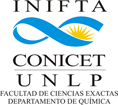CONTACT
·
Instituto
de Investigaciones Fisicoquímicas Teóricas y Aplicadas (INIFTA)
Fac. de
Cs. Exactas. Universidad Nacional de La Plata &
CONICET Diag. 113 y 64
C.C.16 Suc.4 (1900)
La Plata, Bs. As., Argentina
TEL: (+54 221) 425 7430 ext: 144 FAX: (+54 221) 425
4642
WEB: www.inifta.unlp.edu.ar
Facilities
X-Ray absorption spectrometer
·
Rigaku R-XAS
Over the last two decades, X-ray absorption spectroscopy (XAS) has emerged as
an incisive probe of the local structure around selected atomic species in
solids and liquids. Foremost among its strengths are its applicability to
amorphous materials and its tunability; that is, the
ability to probe the environments of different elements in the sample by
selecting the incident X-ray energy. Outside of single crystal X-ray
diffraction and nuclear magnetic resonance (NMR), few other techniques allow
such probing of molecular structure.
·
XAS
Applications
Structural and electronic local environment.
Chemically selective determination in a wide region for absorbing atoms (from
4000 to 25000 eV)
EXAFS:
Coordination number
Bond lengths
Thermal and structural disorder
XANES:
Average oxidation state
Local symmetry
Density of empty states
Electronic transfer
Contact: Dr. Martín Mizrahi (mizrahi@fisica.unlp.edu.ar)
Dr.
José Ramallo-López (ramallolopez@gmail.com)
Langmuir-Blodgett trough
·
The group is equipped a
Langmuir-Blodgett trough (KSV NIMA) for the purpose of investigating water-insoluble monolayers
of organic molecules and nanoparticles, among other
interesting systems, which are spread at the air-water interface. As a main characteristics of monolayers,
the compression isotherms can be recorded in conjunction with their
corresponding potential isotherms.
·
Monolayers can be transfered onto solid substrates
employing the well established Langmuir-Blodgett technology, and the deposited
LB-films can be analyzed by various analytical techniques including imaging ellipsometry, STM/AFM, X-ray reflectivity, GISAXS or
contact angle measurements.
·
The KSV 5000 system 3 is a computer
controlled and programmable Langmuir-Blodgett instrument for the study of monolayers at the air-water interface as well as for the
automated Langmuir film experiments and deposition of normal or alternating multilayers onto solid substrates. The LB Instrument is
equipped with a set of specially designed troughs to broaden and facilitate the
use of the instrument.






